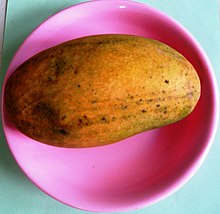| This article includes a list of references, related reading, or external links, but its sources remain unclear because it lacks inline citations. Please help improve this article by introducing more precise citations. (March 2019) (Learn how and when to remove this message) |
| Mangifera 'Dasheri' | |
|---|---|
 | |
| Genus | Mangifera |
| Cultivar | 'Dasheri' |
| Origin | India |

The Dasheri mango is a mango cultivar which originated in a village near Kakori in Lucknow district in 18th century. It is a sweet and fragrant variety of mango grown in North India, the southern state Andhra Pradesh, Nepal, and Pakistan. Malihabad in Uttar Pradesh is the largest producer.
History
Dasheri mango was founded in the 18th century, the mango Dasheri first appeared in the gardens of the Nawab of Dasheri.Since then Dasheri plants have been produced and planted throughout India.The mother plant of Dasheri still exists in " Dashari village" near Kakori Lucknow from where it gets its name.It is now owned by the progeny of Nawab Ansari Zaidi and maintained by them. It is said to be over 300 years old. This mango has the ability to get the attention. Its flavor and aroma are unmatched.

Nutritional benefits
Dasheri mangoes are great source of fibre to help with digestion and vitamin C to boost the immune system. The fruits are an excellent source of zinc, vitamin E, iron, calcium, and other quantities of zinc, vitamin A, folate, and other minerals that support proper organ function. Dasheri mangoes include phytochemicals in the skin that may have antioxidant-like qualities to alleviate inflammation in addition to vitamins and minerals.
Exports
The Dasheri mango is exported internationally to various countries including Singapore, Hong Kong, The Philippines, Malaysia, and other countries in South-East Asia.
References
- Kaushik, Rohit (8 February 2023). "Dasheri Mango- Health Benefits, Uses and Important Facts". PotsandPans India. Retrieved 23 May 2024.
- Kaushik, Rohit (8 February 2023). "Dasheri Mango- Health Benefits, Uses and Important Facts". PotsandPans India. Retrieved 23 May 2024.
External links
This fruit-related article is a stub. You can help Misplaced Pages by expanding it. |
